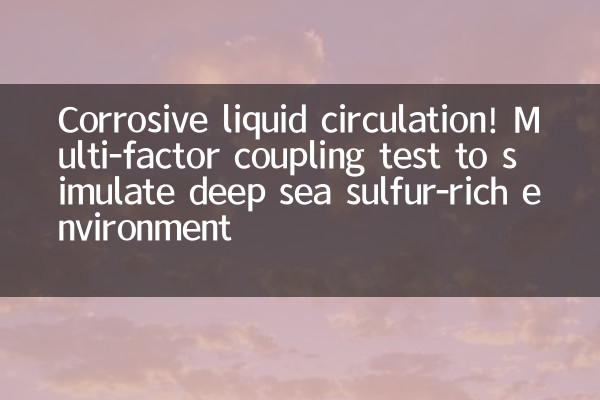Corrosive liquid circulation! Multi-factor coupling test to simulate deep sea sulfur-rich environment
With the continuous development of deep-sea resources, the corrosion of materials in the deep-sea environment has attracted increasing attention. Recently, a project aboutCorrosive liquid circulation multi-factor coupling testThe research results triggered widespread discussion. This study systematically analyzed the corrosion behavior of materials under complex conditions by simulating a deep-sea sulfur-rich environment, providing an important reference for material selection and protection of deep-sea equipment.
1. Research background and significance

The deep sea environment has the characteristics of high pressure, low temperature, high salt, and rich sulfur. In particular, the seafloor hydrothermal area is rich in corrosive media such as hydrogen sulfide, which causes serious corrosion to metal materials. Traditional single-factor corrosion tests are difficult to reflect the real environment, so multi-factor coupling tests have become a research hotspot.
2. Experimental design and methods
The research team designed a corrosive liquid circulation system to simulate the dynamic changes of the deep-sea sulfur-rich environment. The experiment adopts a multi-factor coupling method, including the synergistic effect of pressure, temperature, sulfide concentration, flow rate and other variables. The following are the main parameter settings of the experiment:
| parameter | scope | unit |
|---|---|---|
| pressure | 5-30 | MPa |
| temperature | 2-350 | °C |
| Sulfide concentration | 0.1-10 | mmol/L |
| flow rate | 0.1-2 | m/s |
| pH value | 2-8 | - |
3. Experimental results and analysis
Through 10 days of continuous testing, the research team obtained the following key data:
| Material type | average corrosion rate | Maximum pitting depth | Sulfide influence coefficient |
|---|---|---|---|
| 316L stainless steel | 0.12 | 25.4 | 1.8 |
| Titanium alloy | 0.03 | 8.7 | 0.5 |
| Nickel-based alloy | 0.08 | 15.2 | 1.2 |
| carbon steel | 0.45 | 68.9 | 3.5 |
Experimental results show:
1.Titanium alloyIt performs best in deep sea sulfur-rich environments and has the lowest corrosion rate;
2.Sulfide concentrationThe corrosion effect is most significant on carbon steel;
3.flow rateIncreases will intensify uniform corrosion of all materials;
4.pressure and temperatureThe coupling effect will accelerate the development of local corrosion.
4. Technological breakthroughs and innovations
The main innovations of this study are:
1. Implemented for the first timeCorrosive liquid circulationTest methods coupled with multi-factor dynamics;
2. Developed an experimental system that can simulate rapid changes in deep-sea environmental parameters;
3. A quantitative relationship model between sulfide concentration and corrosion rate was established.
5. Application prospects
The research results can be applied to:
1. Screening and optimization of deep-sea equipment materials;
2. Anti-corrosion design of submarine oil and gas pipelines;
3. Life prediction of deep sea exploration equipment;
4. Establishment of extreme environment materials database.
6. Industry response
This research has caused strong reactions in the fields of materials science and ocean engineering. Many experts said that this multi-factor coupling test method is closer to actual working conditions and is of great significance to improving the reliability of deep-sea equipment. It is expected that more research teams will adopt similar testing protocols in the future.
7. Future Outlook
Research team plans:
1. Expand the types of test materials, including new composite materials and coatings;
2. Extend the test cycle and study long-term corrosion behavior;
3. Develop an intelligent corrosion prediction system;
4. Cooperate with equipment manufacturing companies to promote the transformation of results.
This research not only provides new testing methods for deep-sea materials science, but also provides technical support for the implementation of my country's deep-sea strategy. With the accumulation of test data, a more complete deep-sea material corrosion evaluation system will be formed.

check the details

check the details